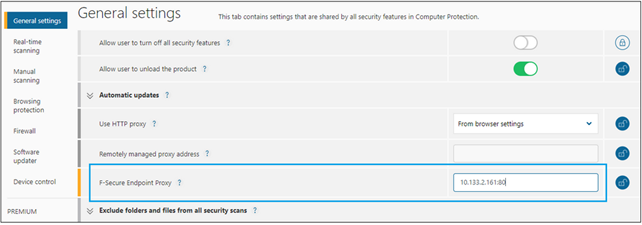Using F-Secure Endpoint Proxy with an F-Secure Elements EPP for Computers profile F-Secure Endpoint Proxy, also known to as Policy Manager Proxy (PMP) is provided by F-Secure to minimize the bandwidth usage while downloading updates to the clients with F-Secure Elements Agent installed.
This proxy caches GUTS2 updates -- the malware signature database. If the PMP is not available, the clients automatically fall back to accessing GUTS2 directly.
To configure the Policy Manager Proxy and use it with F-Secure Elements EPP for Computers profiles:
- Download and install the latest version of F-Secure Policy Manager Proxy.
- For Windows:
- Download the installer here.
- When asked for the Proxy Manager Server address, use 0.0.0.0.
- Check the client updates in the PMP logs:
<installation_directory>/F-Secure/Management Server 5/logs
- For Linux:
- Download the installer here.
Note: Before installing Policy Manager proxy, install the libstdc++ package by running these commands: - Configure the proxy:
- Use the command:
/opt/f-secure/fspms/bin/fspms-config
. - When prompted, provide the server address as 0.0.0.0.
- Manage F-Secure Policy Manager Proxy manually by typing:
/etc/init.d/fspms {start|stop|restart|status}
- Check the client updates in the PMP logs:
/var/opt/f-secure/fspms/logs
What the logs mean: | Log | Explanation |
|---|
request.log | This log lists the requests received from the clients with a response status; for example, a 503 status, means the update is not downloaded from GUTS2 yet, please try again later. |
fspms-serve-updates.log | This log lists what was asked by clients. If some updates are missing and requests are received from the client end with a 503 status, the reasons for this are written in this log. |
fspms-download-updates.log | This log lists the downloads from GUTS2. |
- Configure a F-Secure Elements EPP for Computers profile to use the PMP:
- Go to Profiles > F-Secure Elements EPP for Computers.
- Select the profile that needs modifying, then under General settings find the F-Secure Endpoint Proxy setting.

This setting represents the local server address set in step 1. Once this profile is assigned to the computer, it can also be verified on the client.
- Open the client, then in Settings, select Updates.
Note: You need administrative rights to edit the settings.
- Check the address in the Update server field. This should be an Endpoint Proxy value.
- Select Check now for updates.
The check should execute without any errors.
Note: The Policy Manager Proxy uses port 80 by default. Make sure this is not blocked by the Windows firewall.
If you need to configure Software Updater to work with F-Secure Endpoint Proxy, refer to this article.